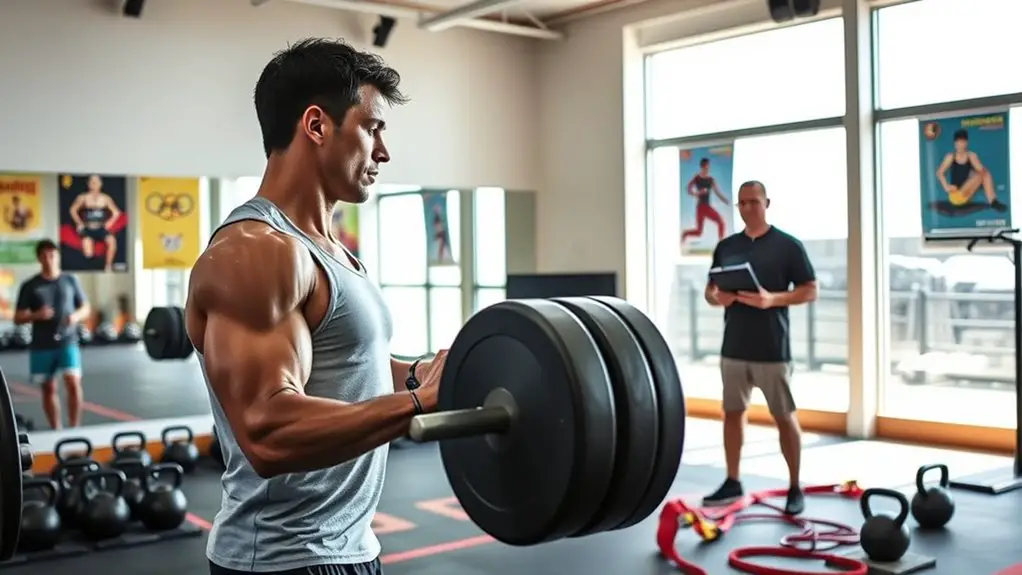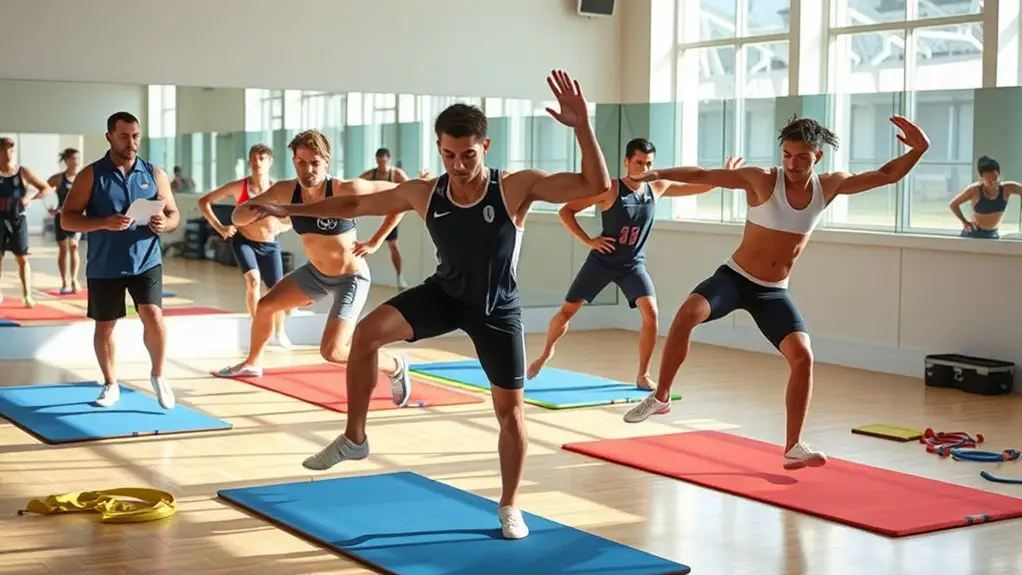How Olympic Athletes Structure Their Gym Training

Olympic athletes structure their gym training using periodization, strategically split into phases to peak at key moments. They customize their workouts based on sport-specific demands—focusing on explosive strength for sprinters or endurance for marathon runners. Strength and conditioning create a solid foundation, while endurance techniques improve cardiovascular capacity. Recovery strategies are essential for performance, ensuring athletes stay healthy and ready. There’s much more to discover about their training approaches, tailored to maximize success.
The Importance of Periodization in Training

When it comes to maximizing performance, understanding the importance of periodization in training can’t be overlooked. Periodization is about structuring your workouts into distinct training phases, each designed to achieve specific goals. This method not only enhances performance but also reduces the risk of injury—a vital aspect for anyone serious about their fitness journey.
Customized Workout Splits for Different Sports
While every sport has unique demands, athletes can greatly enhance their performance by adopting customized workout splits tailored to their specific needs. By focusing on sport specific adaptations, you can guarantee that your training is relevant and effective. For instance, a sprinter may prioritize explosive strength and speed, while a marathon runner should concentrate on endurance and aerobic capacity.
Your training volume should also reflect these differences. It’s essential to balance intensity and recovery, minimizing the risk of injury. If you’re training for a team sport like basketball, incorporating agility and plyometric workouts can help enhance your performance. Additionally, goblet squats can be an effective alternative exercise for athletes dealing with knee issues, allowing them to build strength without aggravating their joints.
Consider working with a coach who understands your sport to develop a split that meets your individual requirements. With a thoughtful approach to your workout splits, you’ll not only improve your skills but do so safely, setting a strong foundation for success in your athletic pursuits.
Strength and Conditioning: Building a Strong Foundation

To excel in any sport, a solid foundation in strength and conditioning is essential. Focusing on muscle hypertrophy and functional strength helps you build a body that’s not only powerful but also resilient. Implementing a structured program will enhance your performance and minimize injury risks. Maintaining an elevated heart rate during workouts is crucial for effective training.
Here’s a simple overview of key strength and conditioning components:
| Component | Purpose | Example Exercises |
|---|---|---|
| Muscle Hypertrophy | Increases muscle size | Squats, Bench Press |
| Functional Strength | Improves everyday movements | Deadlifts, Kettlebell Swings |
| Core Stability | Enhances balance and control | Planks, Medicine Ball Throws |
| Flexibility | Promotes muscle recovery | Stretching, Yoga |
| Power Training | Boosts explosive strength | Olympic Lifts, Box Jumps |
Endurance Training: Going the Distance
When it comes to endurance training, you’ll want to focus on developing your aerobic capacity and mastering interval training techniques. These methods can help you go the distance and improve your overall performance. Let’s explore how to effectively incorporate these strategies into your routine.
Aerobic Capacity Development
Developing aerobic capacity is essential for Olympic athletes, as it lays the foundation for endurance and overall performance. To enhance your aerobic capacity, focus on gradually increasing your training volume while monitoring your heart rate. Aim to reach your aerobic threshold, where your body efficiently uses oxygen. This helps improve your VO2 max, which is the maximum amount of oxygen your body can utilize during intense exercise. Incorporating steady-state runs or cycling sessions at a comfortable pace can help you build a solid aerobic base. Always prioritize safety by listening to your body and allowing adequate recovery time. Remember, consistency is key, so stay committed to your training while ensuring you maintain proper form and technique throughout your sessions.
Interval Training Techniques
Interval training techniques are a powerful way to enhance endurance and boost athletic performance. By incorporating high intensity intervals into your workouts, you can improve your cardiovascular capacity and stamina. Start with shorter bursts of intense effort, followed by periods of active recovery. This approach not only builds strength but also reduces the risk of injury when done correctly.
Additionally, tempo runs are an effective way to maintain a steady pace while challenging your body. Gradually increase the duration and intensity of these runs, allowing your body to adapt. Remember to listen to your body and prioritize proper warm-ups and cool-downs. With these techniques, you’ll be well on your way to achieving endurance goals safely and effectively.
Agility and Flexibility: Key Components of Athletic Performance

Although many people focus on strength and endurance, agility and flexibility are equally important for athletic performance. Developing these skills can help you move more efficiently and reduce the risk of injury. Incorporating dynamic stretches and balance drills into your training can greatly enhance your agility and flexibility.
Consider these key components:
- Dynamic Stretches: They prepare your muscles for movement and improve your range of motion.
- Balance Drills: These exercises enhance stability and coordination, essential for quick changes in direction.
- Flexibility Training: Regular stretching helps maintain muscle elasticity, which is critical for overall athletic performance.
Recovery Strategies: Enhancing Performance Through Rest
Building agility and flexibility is important, but it’s equally essential to prioritize recovery in your training regimen. Effective recovery strategies can enhance your performance and prevent injuries. Incorporating active recovery techniques, like light jogging or yoga, helps keep your muscles engaged while allowing them to heal. Additionally, focusing on sleep optimization guarantees your body gets the rest it needs for muscle repair and mental clarity.
Here’s a quick overview of effective recovery strategies:
| Strategy | Benefits | Tips |
|---|---|---|
| Active Recovery | Reduces muscle soreness | Include low-intensity workouts |
| Sleep Optimization | Enhances recovery and focus | Aim for 7-9 hours per night |
| Hydration | Supports muscle function | Drink water throughout the day |
Frequently Asked Questions
How Do Athletes Balance Training With Competition Schedules?
Imagine you’re a sprinter preparing for a big race. Balancing training with competition schedules means making smart adjustments. You’d focus on your training intensity and volume based on your upcoming events. Post-competition, recovery’s vital—you might incorporate lighter sessions or cross-training to prevent injuries. By listening to your body and adjusting your regimen, you guarantee you’re ready for both training peaks and competitions, all while prioritizing your safety and well-being.
What Role Does Nutrition Play in an Athlete’s Training Regimen?
Nutrition’s essential in your training regimen. Maintaining a proper macronutrient balance—carbohydrates, proteins, and fats—fuels your workouts and aids recovery. You shouldn’t overlook hydration strategies, either; staying well-hydrated helps optimize performance and reduces injury risk. Incorporating nutrient-dense foods and monitoring your intake can enhance your energy levels, ensuring you’re at your best during training and competition. Remember, a well-rounded diet supports your overall health and athletic success.
How Do Athletes Mentally Prepare for Intense Training Sessions?
When you’re gearing up for intense training sessions, mental preparation is key. You might use visualization techniques to imagine yourself executing skills successfully, which can boost your confidence. Incorporating mindfulness practices helps you stay present and reduce anxiety during workouts. By focusing on your breath and tuning into your body, you can create a safe mental space that enhances performance. Remember, a clear mind contributes to a safer and more effective training experience.
What Equipment Do Athletes Typically Use in Their Training?
When it comes to training, athletes typically use a mix of strength training and cardio equipment. You’ll find free weights, resistance machines, and bodyweight exercises for building strength. For cardio, treadmills, stationary bikes, and rowing machines are popular. It’s important to guarantee you’re using the equipment safely, so always pay attention to your form and start with lighter weights if you’re new to strength training. This way, you’ll prevent injuries and maximize your workouts.
How Do Athletes Prevent Injuries During Their Training?
When it comes to injury prevention, you need to prioritize proper technique and listen to your body. Incorporating recovery techniques like stretching, foam rolling, and adequate rest can make a big difference in keeping you safe. Don’t forget to warm up before workouts and cool down afterward; this can help reduce the risk of injuries. Staying hydrated and maintaining a balanced diet are also essential for supporting your body’s recovery and overall performance.





